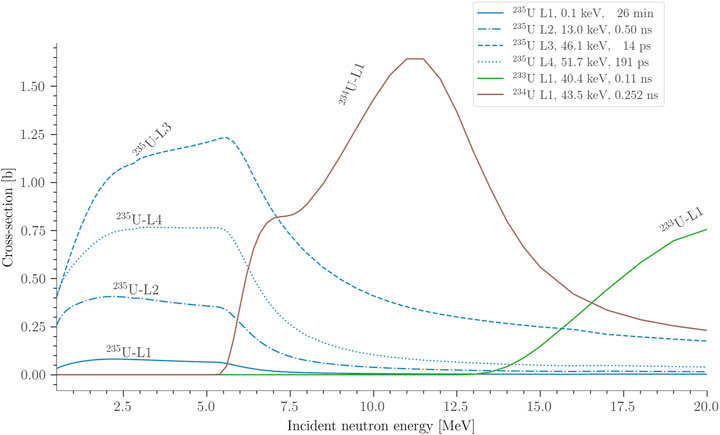- Lawrence Livermore National Laboratory, Livermore, CA, United States
Nuclear reaction rates become nonlinear with respect to flux (cm−2s−1) in extreme environments such as those found during stellar nucleosynthesis and terrestrial nuclear detonations. To observe these effects directly in the laboratory, extremely high particle fluences (cm−2) are necessary but not sufficient. Reactor-based neutron sources, such as the Institut Laue-Langevin’s high-flux neutron reactor, were previously the closest to meeting this challenge, albeit over ∼hour time scales. In ultra-high flux environments, where multiple reactions occur on picosecond time scales, nuclei are unable to return to their ground states between reactions; consequently, reactions take place on excited nuclei. To accurately model high-flux environments, data on the cross-sections of excited nuclear states are required, which differ significantly from those of ground states due to spin/parity effects. In order to replicate these effects in the laboratory, short high-fluence pulses on the order of the lifetime of a typical nuclear excited state (generally ≲1 ns) are required. Particle beams generated by high-intensity lasers are uniquely positioned to meet this need with the potential to produce fluences of 1017 protons/cm2 and 1022 neutrons/cm2 over a few pico-seconds or less. In addition to providing a quantitative analysis of the rates of multiple rapid reactions in general, the present work examines a number of laser-based experiments that could be conducted in the near future to observe multiple rapid reactions for laboratory-based astrophysics and the measurement of exotic cross-sections.
1 Introduction
The rates of certain nuclear reactions in extremely hot and dense environments are determined not only by the nuclear cross-sections of the ground state, but also by the nuclear cross-sections of isomeric states since a significant population of them can be maintained by constant bombardment from high particle flux and electromagnetic processes. While the term “isomer” typically refers to nuclear excited states with half-lives greater than 1 ns, an isomer in the present context is a nuclear excited state with a half-life greater than 1 ps. Most nuclear isomers have an energy range of a few keV to a few MeV and a half-life of less than a few hundred nanoseconds, making sample preparation in sufficient quantity for cross-section measurements extremely difficult for traditional experiments. However, due to its exceptionally low excitation energy of 76 eV coupled with a long half-life of 26 min, the first excited state of
In plasmas with temperatures less than 10 keV, calculations have suggested that isomeric states are strongly populated by energetic neutrons and/or protons as opposed to other electromagnetic processes [2]. Nevertheless, complex processes such as nuclear excitation by electron capture (NEEC) and nuclear excitation by electron transition (NEET) may also contribute significantly despite the fact that previous observations have ranged from inconclusive to controversial [3–5]. The NEEC and NEET processes require the overlap of an atomic and (extremely narrow) nuclear transition. Thus, accurate predictions require very precise knowledge of atomic transitions in a plasma, which is challenging due to density effects, charge screening, and other phenomena. Definitive observation of NEEC and NEET, especially in the plasma environment, will be of great importance to the question of how a population of nuclear isomers is maintained in a plasma.
As the use of high intensity short-pulsed lasers to generate ultra-high flux particle beams has increased in popularity, so has the desire to study isomers and other short-lived nuclei using such beams. It has been proposed that short, high-flux laser-accelerated particle pulses could be used to excite a population of isomers (via both nuclear plasma interactions and other nuclear reactions) while also inducing a nuclear reaction in the excited target population [6]. The astrophysical implications of the maintenance of a thermal population of nuclear excited states by various mechanisms in extreme environments is covered elsewhere, for example see [7]. The present work focuses on the generation and probing of short-lived nuclei by rapid repeat nuclear reactions using energetic particles produced by lasers, as well as the potential for novel cross-section measurements relevant to the astrophysics community as higher fluxes become available. Two nuclear reactions occur on the “same” nucleus during this process, with the first reaction producing the nucleus to be studied, which is then subjected to a second nuclear reaction. The term double reaction is used herein to refer to such a reaction.
In the past, reactor-based neutron sources have utilized double reactions to make cross-section measurements on nuclei as short-lived as
2 Multiple rapid reactions
2.1 Precise definition and significance
During the r-process, many successive nuclear reactions occur on short time scales. Even during terrestrial nuclear detonations, up to 16 rapid neutron captures have been observed [9]. Detailed quantitative analysis of large leaps in nuclear mass up to the neutron drip lines requires the modeling of a large number of reaction channels and is a complex task best left to codes. The observation of more than a few consecutive reactions in sufficient quantities would demand a flux well beyond the capabilities of current facilities. For these reasons, the present work is primarily concerned with double successive reactions of the general form
followed by
where a flux of particle n is incident on a sample of some initial target nucleus, I, producing an intermediate residue nucleus, J, which undergoes a further reaction to produce the final nucleus, K. For example consider double neutron capture on
where * indicates that
Astrophysics is interested in double proton/neutron absorption reactions as a possible pathway to measuring cross-sections on unstable proton/neutron-rich nuclei that are needed to constrain models. Neutron capture cross-sections on unstable nuclei are important to the rapid neutron capture process (r-process), which produces approximately half of the atomic nuclei heavier than iron. Proton absorption cross-sections on unstable nuclei are important to the rapid-proton process (rp–process), which may explain the abundances of a few nuclei that are bypassed by the other known processes. Double capture/absorption reactions are more straightforward to observe experimentally. To see why, consider the following reaction where the incoming proton is not absorbed,
where the cross-sections are taken from the ENDF library and integrated over a typical laser accelerated proton energy spectrum (see Figure 1). The double reaction pathway for the production of
Because the cross-sections of the double reaction pathway are larger than those of the ordinary reaction pathway, it may be tempting to predict that the double reaction pathway will contribute significantly to
The cross-section for the production of
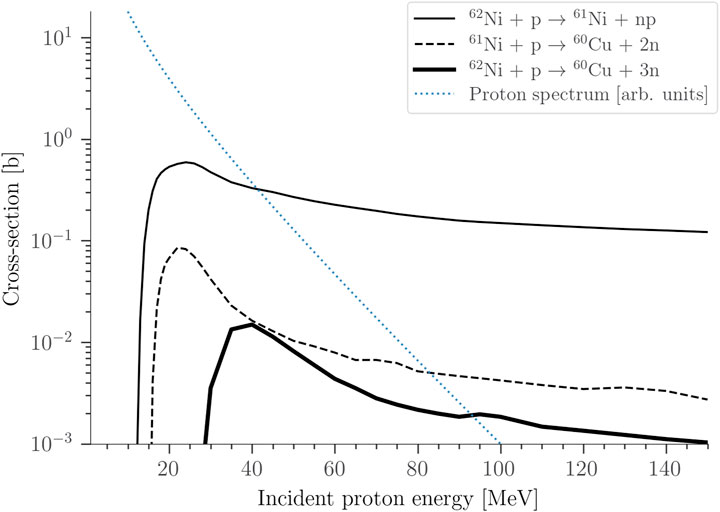
FIGURE 1. Cross-sections for the reactions in Eqs 4 and 5. Taken from the ENDF library. For reference, a typical distribution of laser accelerated proton energies is shown.
2.2 Quantitative analysis of double reaction rates
2.2.1 Simplified mathematical forms
The following assumptions are useful in order to analyze double reaction rates in laboratory conditions:
1. All reactions occur virtually instantaneously (zero pulse width), and
2. Multiple order reaction rates are low relative to ordinary reactions.
Assumption (I) is true if nuclides J and K have a long half-life relative to the pulse width; and hence, species decay is irrelevant. This assumption highlights a benefit of short pulsed lasers: shorter pulse widths make more intermediate states available as short-lived isomers that would otherwise decay to the ground state before a second reaction occurs. Assumption (II) is mathematically true if the inverse of the fluence is much less than the relevant cross-sections, which in practice amounts to a fluence of at least
where I(t), J(t), and K(t) are the time dependent number of the initial target nucleus, the intermediate residue nucleus, and the final nucleus following the double reaction, respectively. ϕ is the flux (cm−2s−1) and NI is the number of target nuclei. σJ is the cross-section for the reaction that produces J from I and σK is the cross-section for the reaction that produces K from J. The diagonal terms of the matrix in Eq. (7) vanish due to the simplifying assumptions described above. Otherwise, the solutions become unwieldy but can be handled using mathematical software if needed. Assumption (II) makes a difference of less than 5% for all figures given in the present work. The solutions of interest to Eq. (7) are
K(t) in Eq. (8) is the total number of double reactions. A lower bound on the fluence (ϕt) in order to observe double reactions is then determined by setting K(t) = 1, giving
2.2.2 General mathematical forms
Eq. (8) is easily generalized to higher order reactions (e.g. triple neutron capture) giving
where n is the number of successive reactions and σi is the cross-section for the ith reaction.
Relaxing assumption (I) by allowing the intermediate nucleus, J, to undergo decay at a rate of λJ per second, the following multiplicative correction factor can be applied to Eq. (8) to get double reaction yield
Since the rate of double-reactions is not linear with respect to the fluence, the following generalization of Eq. (8) must be used in the case of spatially non-uniform fluence
where the angle brackets around σK(E) and σJ(E) represent flux-weighted average cross-sections, F is the fluence, and ρ is the atom density. Because Eq. (12) depends on the square of the fluence, the rates for diverging sources break from the intuition one may have for ordinary reaction rates. Consider the following example. An isotropic point source is embedded in a spherical vacuum of radius r0 and surrounded by material with atom density ρ extending from r0 < r < ∞. The total double reaction yield is, assuming zero attenuation
where a total of s particles are emitted by the point source. Interestingly, the yield of the double reaction is finite despite particles traversing an infinite amount of material, whereas the yield of single, ordinary reactions diverges to infinity.
2.3 Cross-section determination
Because most cross-sections for the population of isomers by inelastic nuclear reactions have not been experimentally measured, the present work uses the TALYS [11] code to estimate cross-sections as needed. The
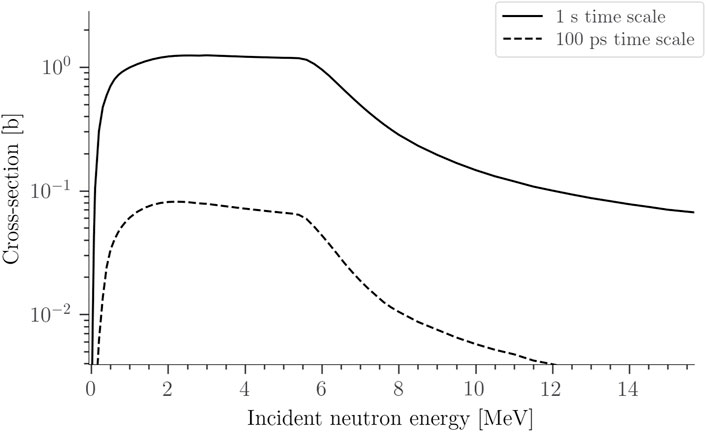
FIGURE 2. Two different TALYS calculations of the cross-sections for the production of the first excited state in
3 Running the numbers
3.1 Neutrons at NIF
3.1.1 Estimated yields
The National Ignition Facility (NIF) currently holds the record for highest neutron flux produced in a lab. Implosion experiments on the NIF vary in their complexity and the neutron yield, thus fluence, that is achievable. Simple gas-filled capsules can produce DT neutron yields of 1014–1015 and are straightforward to execute. More complex “layered” experiments, in which a layer of DT ice is grown against the inner surface of the capsule, are significantly more complex but enable higher yield. Experiments in the “burning plasma” regime have produced neutron yields up to
In the following examples, it is assumed that 1015 target atoms are seeded in the NIF capsule and exposed to a neutron yield of 1017 (fluence = 1021 neutrons/cm2). For a given pair of cross-sections, these conditions give a double reaction yield of
where σJ and σK are the cross-sections for the first and second reactions in units of barns.
3.1.2 Fission on an excited nuclear state
According to cross-sections provided by TALYS, the most numerous fissionable isomer created by neutron interactions on
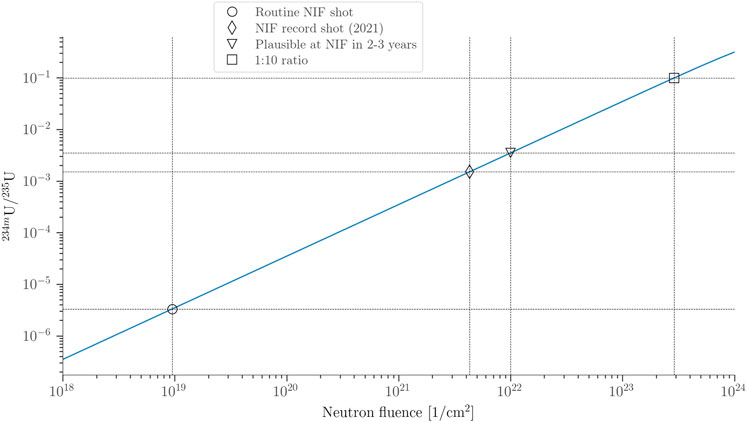
FIGURE 4. Time averaged ratio of
3.1.3 Double neutron capture
In contrast to fission, where the observability of double reaction effects are determined by the ratio of ordinary fission to fission following a secondary reaction, double neutron capture can be observed unambiguously by the detection of (Z, A+ 2) nuclei. While the neutron capture cross-sections for 14 MeV D-T neutrons are quite low, a significant fraction of neutrons at NIF are down scattered to lower energies. Figure 5 depicts the energy spectrum down to 1 MeV; the rates of neutrons with energies less than approximately 1 MeV are poorly understood due to the difficulty of measuring them at NIF [15]; page 76. Even though only a minute fraction of neutron flux is in the thermal energy range, because the cross-sections for neutron capture at thermal energies can be over 100,000 times larger than for MeV neutrons, the low energy neutron component can have a significant effect on capture yields. Note that the calculations below do not include neutron energies below 1 MeV and therefore represent lower bounds on expected yields.
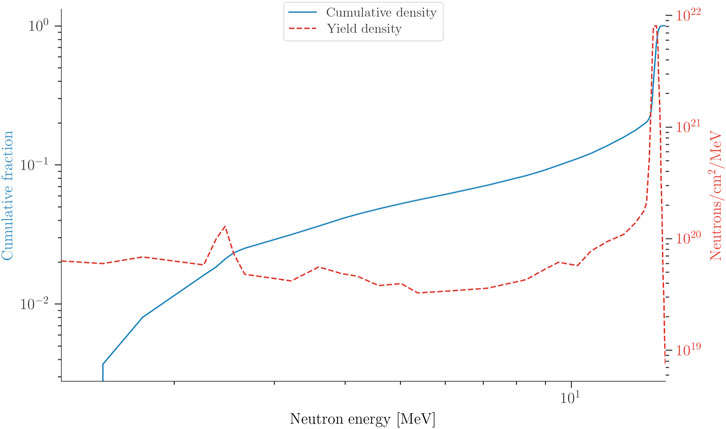
FIGURE 5. Energy distribution of neutrons during a NIF implosion. Data taken from [15]; page 7). The cumulative fraction is also given for the reader’s convenience so that the fraction of neutrons in a given energy range can be quickly estimated by taking the difference between the values at two energies.
Consider double neutron capture on
3.1.4 Other reactions
The production of
and
where the cross-sections, taken from ENDF, are energy-weighted. The usefulness of this example is the high yields. Compared to the example of double neutron capture reaction on
3.2 Protons from TNSA
3.2.1 Estimated yields
Irradiating thin foils with short-pulse, ultrahigh intensity lasers to generate energetic protons is emerging as a promising method for achieving fluxes high enough to be relevant for multiple reactions. In particular, the well-known Target Normal Sheath Acceleration (TNSA) method is distinguished from conventional ion accelerators by its ability to send high count particle bunches into very small areas with a very short pulse length. The best set of conditions within reach of current systems is
where σJ and σK and the cross-sections for the two reactions in barns. Thus, to be readily detectable, the product of the cross-sections of the two reactions must be such that σJσK ≳ 0.001 b2.
3.2.2 Double proton absorption
For example, consider the following double proton absorption reaction on
Using data from ENDF and TALYS for Pb and Bi, respectively, and averaging the cross-sections over a typical TNSA spectrum gives a value of 0.5 b for both reactions. From Eq. (17) this gives a yield of 150
3.2.3 Initial steps at PHELIX facility
In the vicinity of high intensity laser interactions with matter, the majority of conventional nuclear measurement techniques will fail due in part to high peak current, strong electromagnetic pulse (colloquially EMP), and the presence of plasmas. This has motivated the development of a gas transport and collection system in which nuclear reactions occur within a small, hermetically sealed chamber through which inert gas flows, carrying reaction products to a filter where gamma spectroscopy is performed (see Figure 6). A successful proof-of-principle demonstration was conducted at the peta-watt PHELIX laser facility in 2020 [18] using 500 fs,
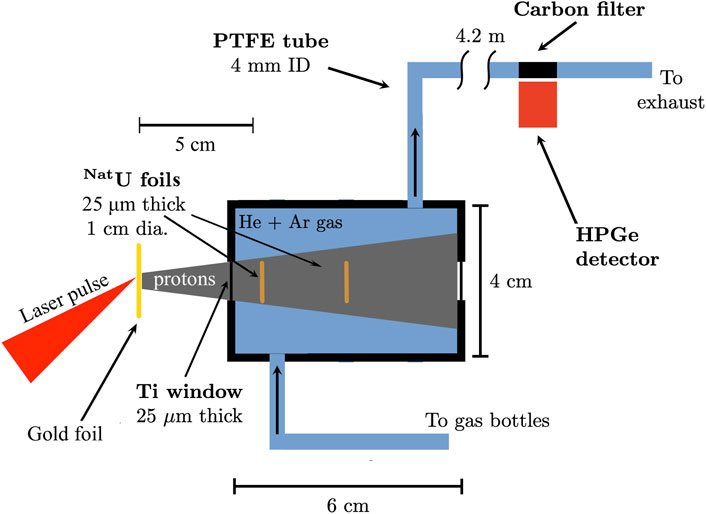
FIGURE 6. Schematic of a gas transport system for the collection of nuclear reaction products that was tested at the PHELIX laser facility.
4 Summary and outlook
The possibility of inducing multiple nuclear reactions in rapid succession has been considered in order to study nuclear reactions on short-lived isomers and exotic nuclei. A set of practical equations with varying degrees of generality for estimating double reaction rates has been developed. Double neutron-capture reactions have been performed using reactors capable of producing 1019 neutrons/cm2/day, but the slow accumulation of fluence precludes studies on short-lived nuclear isomers, which are required to conduct studies relevant to ultra high-flux environments such as those that occur during the r-process. High intensity lasers, while posing new measurement challenges, have the potential to outperform the highest fluence achievable with conventional methods by orders of magnitude, and have pulse lengths down to a few ps to ns.
For reactions where an isotopic signature can be uniquely linked to the double reaction, such as double neutron capture, the necessary fluence is currently readily attainable at NIF using D-T fusion neutrons. Upcoming facilities such as ELI-NP will also meet this threshold with sources of neutrons and protons. For double reactions that do not produce an unambiguous isotopic signature, such as neutron capture followed by neutron induced fission, the experimental fluence required to observe them is much higher, generally greater than
Owing to their ability to squeeze a large number of particles into a very small area in a very short duration, next-generation lasers will be at the forefront of the study of nuclear reactions in extreme environments. A major challenge in the near term will be the adaptation of current measurement methods and instruments to the hostile environment of the high intensity laser, as well as the development of new measurement methods. The present authors hope that this work will serve as a catalyst for additional research and discussions in this emerging field.
Author contributions
JB conceived and drafted the document, while AZ contributed insight and editing.
Funding
This work was performed under the auspices of the U.S. Department of Energy by Lawrence Livermore National Laboratory under Contract DE‐AC52‐07NA27344 and was supported by the LLNL‐LDRD Program under Project No. 20-ERD‐031.
Conflict of interest
The authors declare that the research was conducted in the absence of any commercial or financial relationships that could be construed as a potential conflict of interest.
Publisher’s note
All claims expressed in this article are solely those of the authors and do not necessarily represent those of their affiliated organizations, or those of the publisher, the editors and the reviewers. Any product that may be evaluated in this article, or claim that may be made by its manufacturer, is not guaranteed or endorsed by the publisher.
References
1. D’Eer A, Wagemans C, Nève de Mévergnies M, Gönnenwein F, Geltenbort P, Moore MS, et al. Neutron-induced fission of the 26 min isomer. Phys Rev C (1988) 38:1270–6. doi:10.1103/PhysRevC.38.1270
2. Luu TC, Friar JL, Hayes AC. Electromagnetic excitation rates for nuclear isomers in a hot dense plasma. Nucl Sci Eng (2006) 152:98–105. doi:10.13182/NSE06-A2567
3. Guo S, Fang Y, Zhou X, Petrache CM. Possible overestimation of isomer depletion due to contamination. Nature (2021) 594:E1–2. doi:10.1038/s41586-021-03333-5
4. Chiara CJ, Carroll JJ, Carpenter MP, Greene JP, Hartley DJ, Janssens RVF, et al. Reply to: Possible overestimation of isomer depletion due to contamination. Nature (2021) 594:E3–E4. doi:10.1038/s41586-021-03334-4
5. Rzadkiewicz J, Polasik M, Słabkowska K, Syrocki L, Carroll JJ, Chiara CJ. Novel approach to isomer depletion: Nuclear excitation by electron capture in resonant transfer process. Phys Rev Lett (2021) 127:042501. doi:10.1103/PhysRevLett.127.042501
6. Chen SN, Negoita F, Spohr K, d’Humières E, Pomerantz I, Fuchs J. Extreme brightness laser-based neutron pulses as a pathway for investigating nucleosynthesis in the laboratory. Matter Radiat Extremes (2019) 4:054402. doi:10.1063/1.5081666
7. Rauscher T. Revision of the derivation of stellar rates from experiment and impact on eu s-process contributions. J Phys : Conf Ser (2016) 665:012024. doi:10.1088/1742-6596/665/1/012024
8. Chatani H. Measurement of effective cross section of Th-233(n, γ)Th-234 reaction using the KUR. AIP Conf Proc (2005) 769. doi:10.1063/1.1945097
9. Lutostansky YS, Lyashuk VI. Production of transuranium nuclides in pulsed neutron fluxes from thermonuclear explosions. Jetp Lett (2018) 107:79–85. doi:10.1134/S0021364018020108
10. Zagrebaev VI, Karpov AV, Mishustin IN, Greiner W. Production of heavy and superheavy neutron-rich nuclei in neutron capture processes. Phys Rev C (2011) 84:044617. doi:10.1103/PhysRevC.84.044617
11. Koning AJ, Hilaire S, Duijvestijn MC. Talys-1.0. In: International conference on nuclear data for science and technology. EDP Sciences (2007). p. 211
12. Bélier G, Bond EM, Vieira DJ, Authier N, Becker JA, Hyneck D, et al. Integral cross section measurement of the reaction in a pulsed reactor. Phys Rev C (2015) 91:044605. doi:10.1103/PhysRevC.91.044605
13. Zylstra A, Hurricane O, Callahan D, Kritcher A, Ralph J, Robey H, et al. Burning plasma achieved in inertial fusion. Nature (2022) 601:542–8. doi:10.1038/s41586-021-04281-w
14. Herrmann M. Building to a solution: The elements of a fusion breakthrough (2021). Available from: https://lasers.llnl.gov/news/building-to-a-solution-elements-of-a-fusion-breakthrough (accessed July, 2022).
15. Cerjan CJ, Bernstein L, Hopkins LB, Bionta RM, Bleuel DL, Caggiano JA, et al. Dynamic high energy density plasma environments at the national ignition facility for nuclear science research. J Phys G: Nucl Part Phys (2018) 45:033003–2. doi:10.1088/1361-6471/aa8693
16. Henriques A, Jurado B, Denis-Petit D, Chiron T, Gaudefroy L, Glorius J, et al. Future perspectives for surrogate-reaction studies at storage rings. In: J Escher, Y Alhassid, LA Bernstein, D Brown, C Fröhlich, P Talouet al. editorsCompound-nuclear reactions. Cham: Springer International Publishing (2021). p. 209
17. Borghesi M. Laser-driven ion acceleration: State of the art and emerging mechanisms. In: Nuclear instruments and methods in Physics research section A: Accelerators, spectrometers, detectors and associated equipment, 740. Proceedings of the first European Advanced Accelerator Concepts Workshop 2013 (2014). p. 6–9. doi:10.1016/j.nima.2013.11.098
Keywords: lab-based astrophysics, r-process, national ignition facility (NIF), TNSA, high-intensity laser, fission, isomer, cross-section
Citation: Burggraf J and Zylstra A (2022) Lasers for the observation of multiple order nuclear reactions. Front. Phys. 10:993632. doi: 10.3389/fphy.2022.993632
Received: 13 July 2022; Accepted: 16 September 2022;
Published: 06 October 2022.
Edited by:
Giuseppe Verde, National Institute of Nuclear Physics, ItalyReviewed by:
Tommaso Marchi, Legnaro National Laboratories (INFN), ItalyTheocharis S. Kosmas, University of Ioannina, Greece
Copyright © 2022 Burggraf and Zylstra. This is an open-access article distributed under the terms of the Creative Commons Attribution License (CC BY). The use, distribution or reproduction in other forums is permitted, provided the original author(s) and the copyright owner(s) are credited and that the original publication in this journal is cited, in accordance with accepted academic practice. No use, distribution or reproduction is permitted which does not comply with these terms.
*Correspondence: Jeffrey Burggraf, YnVyZ2dyYWYxQGxsbmwuZ292
 Jeffrey Burggraf
Jeffrey Burggraf Alex Zylstra
Alex Zylstra